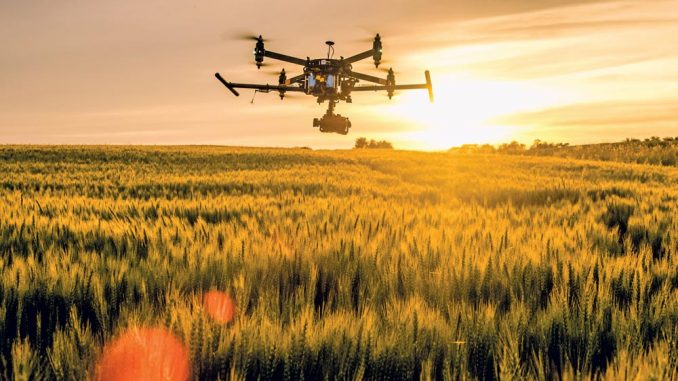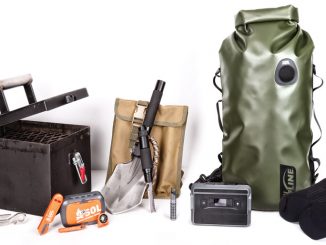
Top-secret security clearance isn’t required to know that the U.S. military regularly utilizes highly advanced “unmanned aerial systems” (UAS), also known as “unmanned aerial vehicles” (UAVs), to conduct long-range reconnaissance, as well as to take out enemy assets. This death-from-above strategy was employed in January, 2020 to kill Iranian General Qassem Soleimani as he left the Baghdad airport.
The aptly named MQ-9 Reaper used in that strike was fitted with Hellfire missiles, but it also had the ability to fly higher than commercial aircraft. As a result, Soleimani likely had no idea it was overhead and probably never knew what hit him.

There are many “low-end” quad rotor drones such as this Propel Neutron model. It’s essentially an entry-level drone for beginners. Drones such as this are still equipped with built-in, high-resolution cameras that can pair with a mobile phone. However, models such as these are little more than toys. (Photo: Propel Neutron)

A man flies a drone with a virtual reality headset.
Such a “drone”—the catchall term for UAVs of all shapes and sizes—is far beyond the reach of any prepper. In fact, in the United States, it’s illegal for anyone to operate armed drones. However, there are many smaller, commercially available drones that could be ideal for someone who would like to put an “eye in the sky.”
Preppers and Drones
Some might question why a drone is something a prepper might even consider having, but because the prices have fallen for these devices, there are several reasons such a device could be worthwhile. The first consideration is that many of today’s civilian drones are designed so that they’re easy to fly and require little, if any, maintenance. As a result, they conform to the KISS principle: “Keep it simple, stupid.”
The bigger reason to have one is that it does provide that view from above, and this can allow you to see potential threats from a greater distance than on the ground. Alternatively, they can help you find a source of water and even get your bearings in those times when GPS might not be an option.

Many commercial drones can carry professional-grade cameras, but these are likely out of the price range of many preppers. However, as with many products, used drones are available. (Photo: Intel Corporation)
There are even those who propose how drones could be equipped with “offensive” tools (such as pepper spray) or used to drop small explosives. As noted previously, it’s illegal to arm drones. But if a time comes when society breaks down and these rules no longer apply, a reasonably powerful drone could provide you with “air supremacy.”
The main reason to have a drone is surveillance, and one could be employed as part of a fairly simple observation system. A drone can allow you to see a large swath of land while staying in a safe location. Deployed with a few solar-powered cameras, you could have a high-tech security perimeter—even if our high-tech world breaks down.


For preppers with a few extra bucks to spare, there are high-end consumer drones such as the DJI Mavic 2 Zoom Drone Quadcopter. Priced at about $1,500, it can stay aloft for over a half an hour and can stream real-time video from a 4K camera. On the ground, it folds up into a small package. (Photo: DJI)
Aerial Platforms
Ideally, most preppers would love to go to the store and pick up that MQ-9 Reaper but, of course, that isn’t an option. In fact, civilians are limited on what types of drones they can acquire. Drones are classified according to their size, but first, it’s important to understand the different types of aerial platforms.
Single-Rotor. Think of these as mini-helicopters. As the name suggests, this type of drone features a fairly large rotor on top, along with the small tail rotor. As a result, it resembles a helicopter. This layout actually allows the drone to generate more thrust than multi-rotor drones, and this can be further increased by a gas-powered motor. However, single-rotor drones are a bit more complex to fly and are not as stable.

A farmer is spraying his crops using a drone to guide him.
Multi-Rotor. When most people envision a simple-to-operate civilian drone, it’s probably the multi-rotor version. This is actually the most common type, and it’s used by both hobbyists and professionals (photographers, news crews, etc.). Multi-rotor drones tend to be the most affordable and the easiest to fly.
Note that “multi-rotor” is actually an umbrella term that can include tricopters, quadcopters, hexacopters and octocopters, so it refers to any drone that has three to eight rotors. Most of these tend to have a few downsides, including the fact that most drones in this category have a flight time of only 20 to 30 minutes; and a general rule of thumb is the more rotors, the less flight time available.

Because of this drone’s small size, it might be possible for it to go unnoticed. Few on the bridge likely saw this Intel Falcon 8+. (Photo: Intel Corporation)
Fixed-Wing. These drones are actually closer in design to those the military uses, just on a much smaller scale (and with no weapons, of course). These drones use many of the same principles of an airplane, including wings to generate lift rather than the vertical thrust provided by rotors. Because the wings generate the lift, the only energy required is for forward motion. This means that the drones can stay airborne longer. A gas-powered version can even stay aloft for up to 16 hours. But fixed-wing drones can’t hover in one spot and must circle a location.
The other downside of fixed-wing drones is that only the smallest models can be launched by hand and also survive a “belly landing.” Most of the bigger ones need something resembling an airstrip.

Single-rotor drones, such as the PRODRONE PDH-03, resemble a miniature helicopter. But these aren’t toys! This drone can reach speeds greater than 124 mph and features an advanced autopilot system. Drones such as this are designed for professional photography but could be ideal as part of an overhead surveillance system. (Photo: PRODRONE)

In addition to using drones for photography purposes, companies such as PRODRONE have developed single-rotor drones that can be used as “delivery flight helicopters.” The PDH-01 has a maximum flight time of an hour and can fly more than 60 miles with a maximum payload of up to 6.6 pounds. It’s a gasoline-powered platform and requires a special operator’s license. (Photo” PRODRONE)
Fixed-Wing Hybrid. The final category of drones is a mix that incorporates a vertical lift motor. It offers many of the benefits of each platform. The biggest benefit is the ability to make a vertical takeoff and then pitch over to fly horizontally. This requires a steeper learning curve than traditional multi-rotor drones. In addition, there’s only a handful of these hybrids available. However, the concept was developed in the 1960s and could be getting a fresh lease on life. In fact, many drone hobbyists and commercial users see the fixed-wing hybrids as the future of small drones.
Size Really Does Matter
Now that you understand the platforms, next is determining the size of the drone … and this really matters—a lot.
It begins with the micro/nano drones, which can be as small as a large-sized insect or as large as 20 inches long. These aren’t ideal for what most preppers have in mind; rather, they’re suited to beginners for indoor flying. These are generally inexpensive, so perhaps this is a good way to see if flying is “in your blood” or if you’re more likely to crash to the ground (like Icarus).
A step up in size comprises the mini and small drones. These can range from 20 to 80 inches in length. Mini drones can fall into the multi-rotor platforms, while many of the small drones are still fixed-wing models. These two size categories are what most hobbyists and many small commercial vendors use. The prices for these drones range from $100 to $1,000 or more.

Octo-drones come in a variety of configurations, and while these don’t have extended flight times, they can often carry more payload than drones with fewer rotors. (Publicity photo)
If that’s not enough drone for you, there are medium drones for larger commercial uses. These can weigh between 400 and 1,000 pounds! Moreover, this means it could take a small crew to handle it. And while these have a far greater range and can stay in the air for hours on end, they require a special license to operate—something most preppers won’t be happy to deal with.
As for size, there are larger drones, but unless you’re in the military, chances are, you won’t get close to one (and if you do, it might be because you’re on the receiving end of one of those Hellfire missiles).
Rules of the Sky
While military drones can fly hundreds of miles and be so high that those on the ground won’t likely know they’re there, most drones that preppers can send up will have a vastly shorter range. In fact, as long as the Federal Aviation Administration (FAA) is around, there are going to be some very strict regulations you’ll need to deal with; and anyone flying in a careless and/or reckless manner could face civil and criminal penalties—including jail time. The FAA can fine individuals up to $27,500 for civil penalties and up to $250,000 for criminal penalties.
For this reason, it’s crucial to know the rules and regulations, which are included here (see the “Sources” sidebar below), based on what the FAA published as of January 2020.

A drone, wireless network and a computer could comprise a good surveillance system. (Photo: Intel Corporation)
The first and most important rule today is that you need to register with the FAA for anything other than an indoor drone. Basically, if it weighs more than 8.8 ounces, it needs to be registered. The fee is $5 (which covers a three-year period). It’s also advisable to consult the FAA website to check for any changes or updates. As is often said, “Ignorance of the law is no excuse.”
Anyone planning to make money with a UAV also needs to pass an FAA test and receive Part 107 certification. For most preppers, this probably isn’t going to be an issue, but keep in mind that drone pilots can be hired to provide photos and videos at everything from weddings to film productions.
For anyone living off the grid or worried about a breakdown of society, a drone can be a good way to get a view from above and be part of an early warning system.

The camera systems in drones can be very sophisticated. This professional Intel Mission Control software can even be used to design the flight plan to perform an inspection of a bridge. (Photo: Intel Corporation)

When people think of a “drone,” something such as the MQ-9 (used to kill Iranian General Qassem Soleimani) likely comes to mind. What most preppers will fly will be considerably smaller. (Photo: USAF/Lt. Col. Leslie Pratt; Public Domain)

Small drones such as the Eagle Pro 6-Rotor Drive feature a built-in Wi-Fi camera and a 2.4GHz remote control. It can be controlled up to 300 feet. However, drones such as this one tend to have only six to eight minutes of operating time per battery. (Photo: Eagle)

Available for less than $300, the Ruko F11 FPV Drone Quadcopter can stay aloft for up to 30 minutes per battery; and it comes with a built-in 4K camera. It utilizes GPS positioning, so as long as there are satellites in the heavens, this one will know where it is! (Photo: Ruko)

Unless a drone’s operator is specially licensed, it’s illegal to fly one over vehicles or people. (Photo: Intel Corporation)

More rotors don’t make drones easier to fly and actually reduce flight time. The YI Erida, introduced a few years ago, was one of the first tricopter drones to feature 4K video cameras. Its carbon-fiber body reduced weight and increased durability. However, professional-grade drones such as the YI Erida can be very expensive new, so preppers might want consider used drones. (Photo: YI Technology)

An Intel Falcon 8+ drone conducts a visual inspection of Minneapolis’s historic Stone Arch Bridge. This highlights how drones can provide a view that’s otherwise inaccessible. (Photo: Intel Corporation)
Classes of UAVs
There are several classes of drones and, while some are obviously only available for military/government use, here is a quick rundown of each.
Micro/Nano
- Weight: Less than 4.4 pounds
- Operating altitude: Up to 200 feet
- Mission radius: 3.1 miles
Mini
- Weight: 4.4 to 44 pounds
- Operating altitude: Up to 3,000 feet
- Mission radius: 15.5 miles
Small
- Weight: 46.3 to 330.7 pounds
- Operating altitude: Up to 5,000 feet
- Mission radius: 31 miles
Class II
- Weight: 33 to 1,323 pounds
- Operating altitude: Up to 10,000 feet
- Mission radius: 124 miles
Class III
- Weight: Over 1,323 pounds
- Operating altitude: Up to 65,000 feet
- Mission radius: Unlimited
Basic Drone Rules
- Fly at or below 400 feet.
- Keep your drone within sight (drones that can fly miles away are grounded).
- Don’t fly in restricted airspace.
- Don’t fly near other aircraft or near an airport.
- Don’t fly over groups of people (you need to remain at least 25 feet away from individuals, as well as vulnerable property).
- Don’t fly over stadiums or sporting events.
- Don’t fly near emergency response efforts, such as fires.
- Don’t fly under the influence.
- Don’t fly in adverse weather conditions, such as high winds or reduced visibility.
- Don’t conduct surveillance or photograph persons without the individual’s permission in areas where there is the expectation of privacy.

Flying a drone isn’t much more complex than flying a model aircraft or playing a video game. (Photo: Intel Corporation)
Accessories
A simple UAV could remain able to fly, even after society has crashed and burned. However, there are a few must-have items you’ll want to stock up on while you can.
- Batteries: If your drone is battery powered, be sure to have a few of these on hand. An electric drone without batteries is just a model. Likewise, have a good solar charging system/hub so those batteries can stay powered-up.
- Propellers: Things break, and this certainly includes propellers. A few spares should be on hand.
- Propeller guards: When the drone isn’t in the air, protect its propellers with guards.
- Carrying bag: While any bag could do in a pinch, a proper carrying bag will help protect the drone during transport.
- SD card: Drones can capture images while in the sky, so have a few SD cards.
- Landing pad: A flat piece of dirt might do, but either buy or build a specific landing pad to help ensure smooth takeoffs and landings.
- Remote controller monitor hood: If you’re flying in bright sunlight and want to see what the camera sees, it might be a good idea to have a hood.

A powerful commercial camera might be out of reach, but if you can get one. it could make an excellent surveillance system.
History of U.S. Military Drones
The concept of unmanned aircraft dates back to before World War II, but drones first emerged in military use to provide surveillance. During the first Gulf War in 1991, the United States regularly employed Pioneer and Pointer drones to conduct aerial patrols along the Saudi-Kuwait border. According to a U.S. Navy report published after the conflict ended, there was at least one UAV in fight at all times during Operation Desert Storm.
The CIA saw the potential and bought five Gnat drones in 1993, which were used to monitor Serbian tank and troop movements during the Balkan wars.
The big “game-changer” came in 2001, when the U.S. military first adopted the Predator, which was fitted with missiles. However, the first attempt to kill an enemy target (Taliban Supreme Commander Mullah Mohammed Omar in 2001) was unsuccessful. The drone fired too early and hit an empty truck. The next year, a Predator was used against a group of men in eastern Afghanistan … one of whom was Osama bin Laden. While he survived the attack, he was wounded, and several of his compatriots were killed.
Between 2008 and 2016, there were 563 drone strikes, and that number has continued to increase since President Trump took office. In addition, the president has since relaxed rules regarding where the U.S. military can use drones.
Sources
Drone Laws KnowBeforeYouFly.org/learn-the-drone-laws/
Drone Regulations: What You Need to Know PCMag.com/news/drone-regulations-what-you-need-to-know
Federal Aviation Administration FAA.gov/uas/
Jane’s Guide to Military Drones IHSMarkit.com/products/janes-all-the-worlds-unmanned-aircraft.html Janes.com/defence/platforms/unmanned-platforms
Editor’s note: A version of this article first appeared in the July, 2020 print issue of American Survival Guide.






Be the first to comment